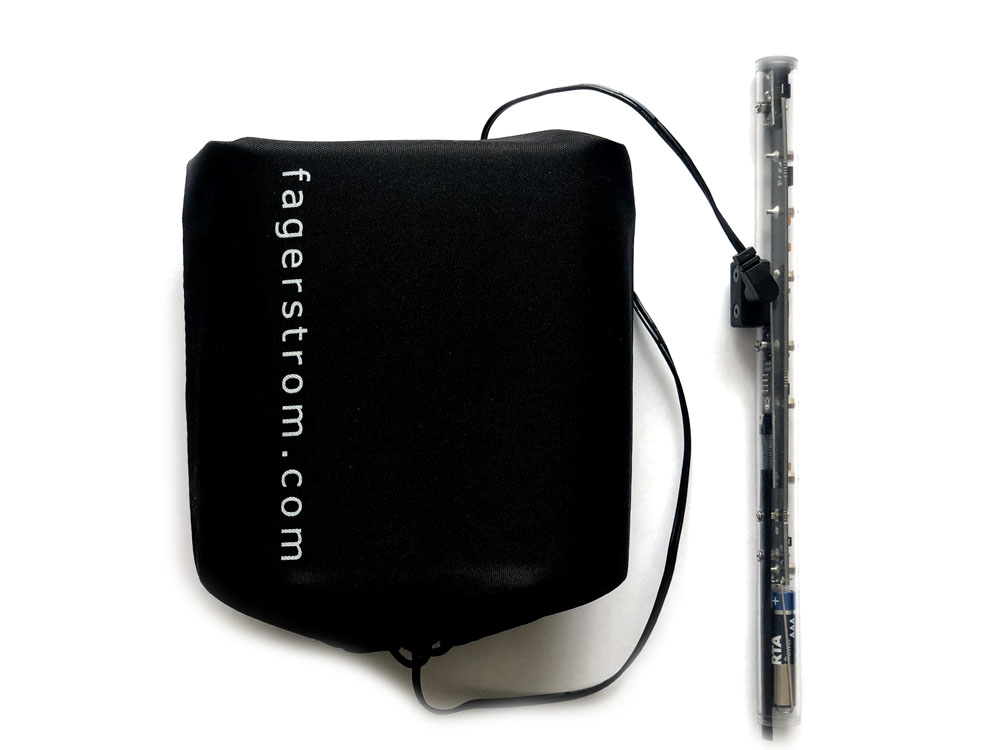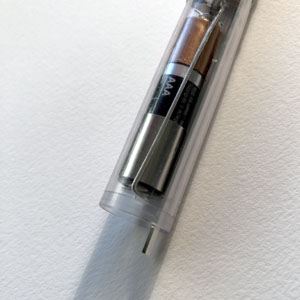uilleann bagpipes
The chanter is available in an Uilleann bagpipes version.
It does not have regulators, and it does not do glissandos. The finger spacing is the same as
that of the Great Highland bagpipes Technopipe. It does not have keys on the chanter, but a fully chromatic
scale can be achieved by cross-fingering.
The chanter can play either an Uilleann or a fully chromatic
Great Highland bagpipes fingering scale. You can very easily change between them.
They all use the same Uilleann sound samples.

THE CONTACTS
The contacts on the chanter are electrical and not mechanical, meaning that
they do not have to be pressed down to achieve contact. The grip does not have
to be any firmer than that on the pipe chanter. The contacts are about 3mm in
diameter, and with their highest point slightly above the surface of the pipe in
order to get a better feel for their position. Worth mentioning is that there is
no electrical "ground contact" on which a finger or any other part of the body
has to rest on, or be connected to, whilst playing.
PLAYING
You start the drones by playing low D, and then the chanter by playing an A.
If you don't want the drones to sound you just play an A. If you want to shut the sound
off, just touch the "sound off" contact at any time and it will go silent.By
pressing the underarm bag like octave switch, the notes of the second octave
are played.
The bottom sensor acts as low D valve to enable staccato playing. (See image below.)
The bottom sensor can easily be disabled.

SETTINGS/CONTROLS
There are two contacts that are used to control all settings. To adjust a
setting, just hold the relevant fingering combination and use the control
contacts.
The following can be controlled:
- Sensitivity: Since the fingers sometimes can be very dry, causing them to
become poor conductors, and sometimes quite sweaty, leaving a sweat film on the
chanter short-circuiting the contacts, the sensitivity is possible to set. Most
of the time though, the setting of the sensitivity can be ignored.
- Pitch: The chanter starts in the key of D (294Hz), and the low D goes from 92Hz up to 369Hz in steps of 0.1 to 0.7Hz.
The key of the chanter can easily be set to A(220Hz), Bb, C, or D.
- Metronome: easy to start in desired tempo. Sub-beats can be added.
- Drones: volume relative to chanter. The drones are always in tune with and follows the key of the chanter.
- Scale: The chanter can play two different scales:
1) A chromatic scale, tuned to harmonise with the drones: so called harmonic tuning.
2) A chromatic scale with equally tempered tuning. This tuning is usually the best for playing together with other instruments.
- Fingering: The chanter can play two different fingerings:
1) Uilleann fingering with cross-fingering for a fully chromatic scale.
2) Great Highland bagpipes fingering with cross-fingering for a fully chromatic scale.
- Volume: affects chanter, drones, and metronome.
- Recording: more than 1200 notes can be recorded. During playback, the
recorded notes are sounding on the right channel, and you can play along on the
left. The playback speed can be set between ¼ and 2 times the recorded speed.
MIDI
MIDI (Musical Instrument Digital Interface) is an electronic communications
protocol that enables electronic musical instruments, computers, and synthezises etc.
to communicate with each other. MIDI does not transmit an audio signal -
it transmits digital data messages defining parameters such as pitch and
volume of the musical notes to play. See http://www.midi.org for further reading.
You enter MIDI mode by holding a specific fingering combination and then
inserting the MIDI cable plug to switch the chanter on.
The chanter is initially set to channel 1, but can be set between 1 and 14.
The bass is fixed on channel 15 and the tenor fixed on channel 16.
In MIDI mode the metronome and recording are not
available.
The pitch is adjusted in semi-notes.
The volume settings for chanter and drones affect the "velocity" of the MIDI
note. On some devices the velocity is the same as the volume for the note, on
others it isn't. It is up to the receiving device to interpret the velocity
data.
If the receiving device allows it, vibrato effect can be achieved by pitch bend messages sent by the pipe.
In MIDI mode the power consumption is lower and the chanter will run for
approx. 20 hours on a rechargeable 1000mAh NiMH battery.
DIMENSIONS
The length of the pipe is 249mm and the diameter is 16mm. Despite the small
dimensions this is a full-size chanter and the spacing of the contacts is the
same as the spacing of the holes on a (GHB) pipe chanter. The dimensions together with
the low weight of approx. 60 grams, make this chanter very portable indeed.
ADDITIONAL INFORMATION
The manual
Fingering chart
SOUND SAMPLES
CREDIT
I have received great help from the Swedish Uilleann piper Erik Ask-Upmark.
The final development however, has been made together with
Michael Eskin, the US Uilleann piper and iOS app developer. In fact, the
fingering and octave switching method corresponds exactly to that of his famous
Uilleann pipes iPad app. The Uilleann version of the Technopipes can work as a
MIDI controller for the iPad app with its built-in rich sound samples. More
information, pictures, and video clips are available at
www.facebook.com/michaeleskin.
(It will of course also work with other existing apps as a MIDI controller.)


